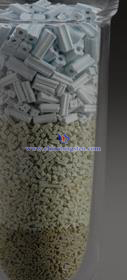WO3 Hydrodesulfurization Catalyst - Regeneration Flue Gas Treatment 2/2
- Details
- Category: Tungsten Information
- Published on Wednesday, 11 May 2016 18:05
 3. Preparation of the finished catalyst
3. Preparation of the finished catalyst
Add a complexing agent of active ingredient (citric acid or phosphoric acid) in deionized water, then heated to above 70°C, and the required amount of tungstate, cobalt and nickel salt are added under continuously stirring, stop until the solid completely dissolved, to obtain co-infusion of the active ingredient; impregnating the semi-finished catalyst into the co-infusion of active component for 0.5~1 hour, then drying at 110~150°C for 2~6 hours, calcining at 200~500°C for 2~5 hours to obtain the final tungsten trioxide hydrodesulfurization catalyst. Wherein the content of tungsten oxide is 12%~15%; nickel oxide is 1.0% ~1.5%; cobalt oxide is 2.0%~3.0%; ferrous sulfate is2%~4%; titanium dioxide is 20%~30%; the rest is γ-aluminum-oxide.
NOx gases are avoided to produce during the preparation of this tungsten trioxide hydrodesulfurization catalyst, because no metal nitrate is used, to make the production process clean and pollution-free. The using method is to inlet a sulfur-containing gas into the tail gas hydrogenation unit of the sulfur recovery equipment, and then regenerated; the hydrogen sulfide after regeneration returns to the Claus sulfur recovery unit for recovering sulfur, the purified exhaust discharge under the standard after burning by the incinerator.
Advantages of this desulfurization treatment are as following:
1. The low using temperature which can be used in the hydrogenation of sulfur-containing gases at an inlet temperature of 220~280°C;
2. Without adding any facilities, sulfur-containing gas may be directly treated after introduced into the sulfur means tail gas treatment unit, which makes it an ideal treatment approach sulfur-containing gas;
3. The regenerated hydrogen sulfide returning to the process can not only recover the sulfur resource, but also avoid environmental pollution;
4. The activity of this kind of tungsten trioxide hydrodesulfurization catalyst is 30% higher than the conventional Claus tail gas hydrogenation catalyst, and the using temperature is lower for 60°C or more, with the excellent economic and environmental benefits by saving energy.
| Tungsten Oxide Supplier: Chinatungsten Online www.tungsten-oxide.com | Tel.: 86 592 5129696; Fax: 86 592 5129797;Email:sales@chinatungsten.com |
| Tungsten News & Prices, 3G Version: http://3g.chinatungsten.com | Molybdenum News & Molybdenum Price: http://news.molybdenum.com.cn |



 sales@chinatungsten.com
sales@chinatungsten.com